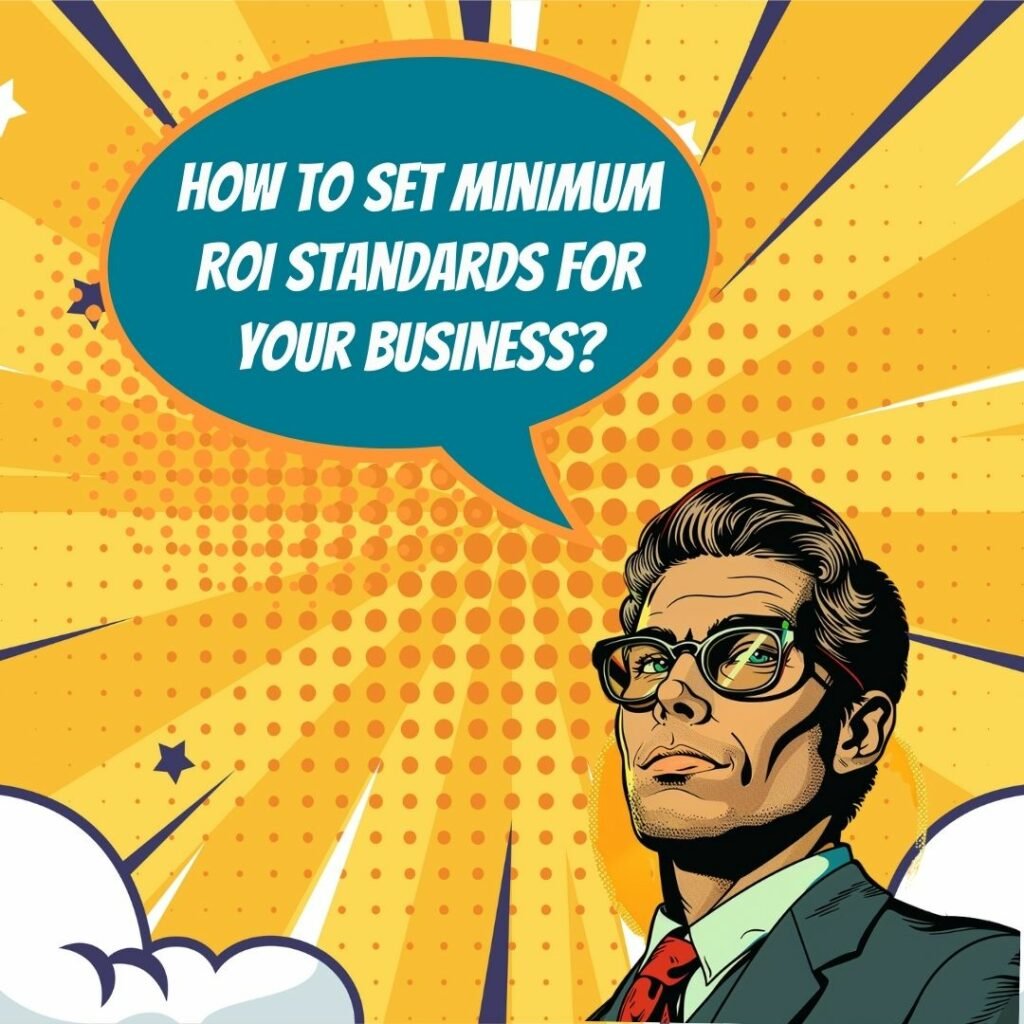Key Takeaways
✅ Industry and Context Matter: It's crucial to know that a one-size-fits-all approach doesn't apply to ROI. While a 10% to 15% return might be stellar in certain sectors, in others, even a modest 1% to 2% could be the mark of success. Research shows that ROI can fluctuate widely, with average figures varying across industries — retail, for example, often sees an ROI of around 5-10%, whereas software companies may target an ROI of 15-20%.
✅ Risk Tolerance and Time Horizon: Every investor's approach to risk influences the kind of ROI that is acceptable for their business. Are you the type to play it safe and prefer steady returns over the long haul, or are you willing to ride the waves of uncertainty for potentially higher gains? Typically, investments that are kept for longer periods need to bring in a higher ROI, as they tie up capital for extended periods.
✅ Minimum Standards and Financial Goals: At a bare minimum, your investments should be returning more than a dollar for each dollar spent. However, defining a 'good' ROI also hinges on your company's aspirations — are you looking to grow quickly or aiming for steady sailing? When we talk about What ROI is Acceptable for Your Business?, always consider how your financial targets align with your ROI benchmarks.
 Introduction
Introduction
What does success look like to you? When discussing minimum standards and financial goals, understanding the acceptable ROI for your business can feel like deciphering an ancient code. It's the magic number that tells you whether your investments are truly paying off. But pinpointing that number isn't just about hitting some industry average — it's about aligning your financial strategies with the unique heartbeat of your business.
In the journey through the numbers and narratives that shape What ROI is Acceptable for Your Business?, this article isn't just another data-drenched deep-dive. Instead, it offers a fresh perspective, blending market intelligence with practical advice, tailored not just to maximize revenue but to resonate with your long-term vision. As you turn these pages, expect to uncover actionable insights — the kind of groundbreaking information that could redefine your financial targets and transform how you measure success.
Top Statistics
| Statistic | Insight |
|---|---|
| General ROI Expectation: 5-7% | This baseline serves as a point of comparison and goal-setting for new businesses and investors. |
| Technology Industry Average ROI: 28.87% | With an ROI this high, tech investments can be an attractive opportunity, considering the sector's rapid growth and innovation. |
| Digital Marketing ROI: 25-50% for advertising | Advertising, particularly with methods like pay-per-click, can deliver substantial returns, indicative of effective marketing strategies at play. |
| Agency ROI Expectations: 5% minimum to 20% | For agencies, this range provides a benchmark to assess the performance of their marketing campaigns and client strategies. |
| SEO and Web Traffic: 91.5% from high-ranking sites | The staggering majority of web traffic coming from the top of search results underscores the value of investing in SEO for long-term visibility. |
Understanding ROI: A Quick Overview
ROI, or Return on Investment, is a fundamental concept in the world of business, reflecting the performance of an investment. It's a simple yet potent measurement that answers a straightforward question: for every dollar invested, how much money did you get back? Understanding ROI is critical not just for assessing past decisions but also for guiding future business strategies. Calculating ROI is a straight-up math problem—subtract the investment cost from the net profit (the money made from the investment), then divide that number by the investment cost, and voila, you've got your ROI percentage. This metric helps businesses evaluate the efficiency of their investments and make data-driven decisions.
Setting Minimum Standards for ROI
Setting a benchmark isn't as easy as picking a number out of a hat. For instance, in the tech industry, an ROI of 10% might seem meager, whereas in retail, that could be cause for celebration. Why? Because industry benchmarks fluctuate wildly due to variables such as market saturation, consumer behavior, and economic tides. A savvy investor must consider these external factors, coupled with their own operational costs, when setting their minimum acceptable ROI standard. Understanding these nuances helps businesses set realistic and industry-specific ROI targets. Regularly revisiting and adjusting these standards ensures they remain aligned with market conditions and business goals.
Balancing Financial Goals and ROI Expectations
The tale of short-term vs. long-term ROI goals spins on the axis of time. Quick returns can offer the financial cushion needed to keep a business ticking over, addressing immediate needs and responsibilities. Meanwhile, the visionary looks beyond the horizon, targeting strategic investments that may not pay off this quarter, or even this year, but lay the foundation for future sustainability and expansion. Striking a balance between these temporal goals often means juggling immediate necessities with long-term dreams. This balance is crucial for maintaining business stability while pursuing growth opportunities. Effective financial planning involves setting both short-term and long-term ROI targets that complement each other.
Factors Influencing Acceptable ROI
ROI is not a one-size-fits-all figure. A company's acceptable ROI is heavily linked to risk tolerance and the nature of the investment. A gutsier business diving into high-risk ventures may not bat an eyelid at an ROI threshold of 20% or more. In contrast, a conservative approach might peg the acceptable ROI around 5%, particularly when the stakes are workaday expenses that keep the ship steady. In each business stage—startup, growth, maturity—ROI expectations may shift, reflecting the enterprise’s changing capacity for risk and varying priorities. Tailoring ROI expectations to the business’s current phase ensures appropriate risk management. Regularly revising these expectations helps align them with evolving business goals and market conditions.
Evaluating and Adjusting ROI Expectations
What makes ROI a particularly useful tool is its elasticity—it can (and should) be adapted over time. Regular ROI assessment and analysis is pivotal in keeping up with both the company's internal progress and the eternal jostling of the market. Discovering that a certain financial year's ROI has plummeted can ignite a search for improvable aspects or inefficiencies within the business. On the flip side, strong ROI outcomes might encourage a business to realign its investment strategies, perhaps shifting from survival mode to a more audacious, market-leading posture. Adjustments in ROI goals, based on the pounding heartbeat of a business’s performance, are not just shrewd—they're essential for growth. Consistent evaluation helps businesses stay agile and responsive to market dynamics.
The Strategic Value of ROI Analysis
Analyzing ROI is not just about crunching numbers; it's about gaining insights that drive strategic decisions. By understanding which investments yield the best returns, businesses can allocate resources more effectively. This strategic allocation helps optimize overall performance and profitability. Furthermore, ROI analysis can reveal hidden opportunities and areas for improvement. It empowers businesses to pivot and adapt strategies to maximize returns. Embracing ROI analysis as a regular practice ensures that businesses remain proactive and competitive in their respective markets.
AI Marketing Engineers Recommendation
Recommendation 1: Understand and Set Industry-Specific ROI Benchmarks: Before diving into what an acceptable ROI is for your business, it's crucial to have a clear understanding of your industry's standards. Various sectors have different average ROI due to market size, customer value, and life cycle. For instance, the software industry often sees higher ROI due to recurring revenue streams (like subscription models) leading to higher lifetime customer value. An eMarketer study found the average ROI on email marketing to be 122%, but this might be significantly different when compared to industries like manufacturing. Hence, tailor your ROI goals based on detailed industry data and competitive analysis.
Recommendation 2: Leverage Incremental ROI Measurement for Precision: In a dynamic business landscape, an effective strategy is to track Incremental ROI from specific campaigns or changes in strategy. By focusing on the incremental changes, you can identify what tactics are driving improvements, substantiating this with A/B testing, where changes in marketing strategy can result in variations of ROI. Through incremental measurement, businesses can also adapt to change more quickly. For example, a Nielsen study has shown that companies that employ marketing-mix modeling to assess incremental ROI are more likely to see an improvement in their marketing effectiveness.
Recommendation 3: Utilize ROI-Focused Tools for In-Depth Analysis: In today’s data-driven market, utilizing analytical tools is a non-negotiable aspect of a successful strategy. Tools like Google Analytics, Kissmetrics, or Tableau provide insights into customer behavior, campaign performance, and conversion tracking, which are essential for calculating ROI. These tools allow for deep dives into metrics that matter and enable the fine-tuning of strategies for better financial outcomes. The use of such analytical tools not only informs on where to invest but also how to optimize investments to achieve and exceed the minimum ROI standards necessary for sustained growth and profitability.
Relevant Links
- Revolutionize Your Digital Marketing with AI
- Mastering SEO for Baidu: Boost Your Visibility in China
- Harness Analytics to Navigate China's Digital Market
- Crafting Winning PPC Campaigns in China
- Performance Marketing Insights for India
Conclusion
Understanding Return on Investment (ROI) is not just a fancy concept; it's the bread and butter of savvy business decision-making. Whether you're running a retail store, a tech startup, or a financial firm, the clarity on what ROI is acceptable for your business can mean the difference between thriving and merely surviving. Industry benchmarks offer a starting point, but it's the deep dive into your company's financial goals that truly shapes the ROI you should be aiming for.
While some industries boast higher average ROI than others, this isn't a one-size-fits-all situation. Your acceptable ROI is influenced by market conditions, competition, and the stage of your business. Are you in startup mode, focused on aggressive growth, or maintaining a mature company? Each phase demands a different ROI target. Risk tolerance also plays a pivotal role, as does the nature of your investments—high-risk ones typically require a higher ROI to be deemed successful.
Striking the right balance between short-term wins and long-term strategy is crucial. Immediate cash flow may require prioritizing short-term ROI, but for sustainable growth, keeping an eye on those long-term outcomes is key. Regular assessment and adjustment keep your financial goals aligned with performance. If your business is consistently hitting or exceeding its ROI goals, it might be time to raise the bar; if not, perhaps a realignment or strategy shift is in order.
In sum, there is no 'magic number' for an acceptable ROI. It's a blend of your business's unique landscape and your financial aspirations. By consistently monitoring ROI performance and staying adaptable, you can navigate your business toward success in any market. Let this be your call to speak to a financial analyst, gather your data, and set a benchmark that's right for your business's big picture.
FAQs
Question 1: What is ROI?
Answer: ROI is a way of thinking about the profits an investment provides compared to the money you put into it.
Question 2: How is ROI calculated?
Answer: It's like baking a cake with dollars and seeing how much more dough rises up. You take what you earned, slash it with the investment you made, and voila! Percentage of your profit.
Question 3: What is a good ROI for a small business?
Answer: Good ROI? That's like asking what a good spice level is for salsa—depends on who's eating! But for most small businesses, if they're seeing returns of 15% to 30%, they're usually in the happy zone.
Question 4: What is a good ROI for digital marketing initiatives?
Answer: Digital marketing ROI is a tough one, isn't it? It's like catching fog sometimes. But if your SEO is getting you top spots on Google or your PPC ads are making more than they cost, you're on the right track.
Question 5: How does ROI impact business decisions?
Answer: It's the compass for businesses, pointing to where the treasure lies and what paths to avoid. ROI helps bosses make smart choices on where to put their cash.
Question 6: How does ROI account for qualitative returns?
Answer: Qualitative returns are like trying to measure love or joy, but even they can sometimes be squeezed into ROI with some creative math, capturing things like time spent and heartache—not just cold, hard cash.
Question 7: What are the limitations of using ROI?
Answer: Well, ROI isn't perfect. It can miss stuff like future costs, the excitement of what you're doing, or that pesky fine print in the investment brochure.
Question 8: How can I improve my ROI?
Answer: To boost your ROI, think of squeezing a lemon - get more juice from your sales, cut back the pulp from your expenses, and keep a sharp eye on your investments to squish out every drop of profit.
Question 9: What are some common ROI mistakes to avoid?
Answer: Hunters can miss their shot if they don't consider the wind—same with ROI. Folks often forget to factor in every penny they spent or don’t have clear targets.











